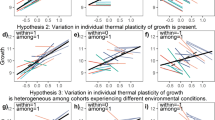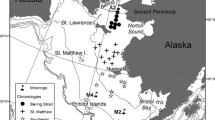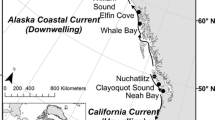Abstract
Whitespotted conger (Conger myriaster) is a commercially important species in East Asia; however, the fisheries stock has drastically declined in recent years. Environmental changes are assumed to have profound impacts on the growth of this species, yet the mechanisms that regulate growth remain poorly understood. Here, we used otolith measurements to establish a 9-year growth chronology for whitespotted conger in the Yellow Sea and evaluated the effects of environmental variables on inter-annual variability in growth. Linear mixed-effects models were used to explain growth variation with abiotic and biotic variables, including seasonal water temperature, prey availability, and population density, and to assess age-dependent responses in growth and the interactions between abiotic and biotic factors. The results indicated that the growth of whitespotted conger was positively correlated with seasonal water temperature (except autumn) and prey abundance per capita, and the contribution of sea water temperature was more important than prey availability to explain growth variation. The model detected significant negative interactions between spring sea temperature and prey availability, indicating a higher degree of temperature-dependent growth when prey availability was low. Our findings imply that the growth of whitespotted conger is less influenced by food availability. This study provided the first evidence for the joint effects of abiotic and biotic factors on the growth variation of whitespotted conger, and the information is key to understanding population dynamics, and will help shape the sustainable management of fisheries.




Similar content being viewed by others
Data/code availability
The datasets generated during and/or analyzed during the current study are available from the corresponding author on reasonable request.
References
Bates D, Mächler M, Bolker B, Walker S (2015) Fitting linear mixed-effects models using lme4. J Stat Softw 67(1):1–48. https://doi.org/10.18637/jss.v067.i01
Boltaña S, Sanhueza N, Aguilar A, Cristian G, Gabriel A, Juan A, Doris S, Renato A (2017) Influences of thermal environment on fish growth. Ecol Evol 7:6814–6825. https://doi.org/10.1002/ece3.3239
Boulenger C, Alain C, Charrier F, Roussel JM, Feunteun E, Acou A (2016) Difference in factors explaining growth rate variability in European eel subpopulations: the possible role of habitat carrying capacity. Ecol Freshw Fish 25:281–294. https://doi.org/10.1111/eff.12209
Campana S, Thorrold S (2001) Otoliths, increments, and elements: keys to a comprehensive understanding of fish populations? Can J Fish Aquat Sci 58:30–38. https://doi.org/10.1139/cjfas-58-1-30
Feng LC, Zhang RH, Wang ZG, Chen XR (2015) Processes leading to second-year cooling of the 2010–12 La Niña event, diagnosed using GODAS. Adv Atmos Sci 32(3):424–438. https://doi.org/10.1007/s00376-014-4012-8
Fox J (2003) Effect displays in R for generalised linear models. J Stat Softw 8(15):1–27. https://doi.org/10.18637/jss.v008.i15
Gao G, Marin M, Feng M, Yin B, Yang D, Feng X, Yang D, Song D (2020) Drivers of marine heatwaves in the east china sea and the south yellow sea in three consecutive summers during 2016–2018. J Geophys Res-Oceans. https://doi.org/10.1029/2020JC016518
Gelman A, Hill J (2006) Applied regression and multilevel (hierarchical) models. Gen Inf 45(1):94–97. https://doi.org/10.1017/CBO9780511790942
Gertseva V, Cope J, Matson S (2010) Growth variability in the splitnose rockfish Sebastes diploproa of the northeast Pacific Ocean: pattern revisited. Mar Ecol Prog Ser 413:125–136. https://doi.org/10.3354/meps08719
Gorie S, Tanda M (2004) Growth and stomach contents of juvenile white-spotted conger Conger myriaster. Suisanzoshoku. 52:139–144. https://doi.org/10.11233/aquaculturesci1953.52.139
Harley C, Hughes A, Hultgren K, Miner B, Sorte CJB, Thornber C, Rodriguez LF, Tomanek L, Williams S (2006) Erratum: the impacts of climate change in coastal marine systems. Ecol Lett 9:228–324. https://doi.org/10.1111/j.1461-0248.2006.00917.x
Heather FJ, Childs DZ, Darnaude AM, Blanchard JL, Patrick P (2018) Using an integral projection model to assess the effect of temperature on the growth of gilthead seabream Sparus aurata. PLoS One 13(5):e0196092. https://doi.org/10.1371/journal.pone.0196092
Hori T, Noda T, Wada T, Iwasaki T, Arai N, Mitamura H (2019) Effects of water temperature on white-spotted conger Conger myriaster activity levels determined by accelerometer transmitters. Fish Sci 85(2):295–302. https://doi.org/10.1007/s12562-019-01289-0
Kim YH, Lee EH, Kim JN, Choi JH, Oh TY, Lee DW (2011) Age and growth of whitespotted conger Conger myriaster in the southern coastal waters of Korea. Korean J Fish Aquat Sci 44(6):689–694. https://doi.org/10.5657/KFAS.2011.0689
Kurogi H, Mochioka N, Okazaki M, Takahashi M, Miller MJ, Tsukamoto K, Chow S (2012) Discovery of a spawning area of the common Japanese conger Conger myriaster along the Kyushu-Palau Ridge in the western North Pacific. Fish Sci 78(3):525–532. https://doi.org/10.1007/s12562-012-0468-6
Lee Q, Punt A (2018) Extracting a time-varying climate-driven growth index from otoliths for use in stock assessment models. Fish Res 200:93–103. https://doi.org/10.1016/j.fishres.2017.12.014
Liu XF, Liu H, Xue Y, Ji YP, Li SY, Han DY (2015) Feeding ecology of C. myriaster in Haizhou Bay. J Fish Sci China 22(3):517–527. https://doi.org/10.3724/SP.J.1118.2015.14334
Lorenzen K (2016) Toward a new paradigm for growth modeling in fisheries stock assessments: embracing plasticity and its consequences. Fish Res 180:4–22. https://doi.org/10.1016/j.fishres.2016.01.006
Lorenzen K, Enberg K (2002) Density-dependent growth as a key mechanism in the regulation of fish populations: evidence from among-population comparisons. Proc Biol Sci 269:49–54. https://doi.org/10.1098/rspb.2001.1853
Machut L, Limburg K, Schmidt R, Dittman D (2007) Anthropogenic impacts on American eel demographics in hudson river tributaries, New York. Trans Am Fish Soc 136:1699–1713. https://doi.org/10.1577/T06-140.1
Miller MJ, Yoshinaga T, Aoyama J, Otake T, Mochioka N, Kurogi H, Tsukamoto K (2011) Offshore spawning of Conger myriaster in the western north pacific: evidence for convergent migration strategies of anguilliform eels in the atlantic and pacific. Naturwissenschaften 98(6):537–543. https://doi.org/10.1007/s00114-011-0787-y
Morrongiello JR, Thresher RE (2015) A statistical framework to explore ontogenetic growth variation among individuals and populations: a marine fish example. Ecol Monogr 85:93–115. https://doi.org/10.1890/13-2355.1
Morrongiello J, Walsh C, Gray C, Stocks J, Crook D (2014) Environmental change drives long-term recruitment and growth variation in an estuarine fish. Glob Chang Biol 20(6):1844–1860. https://doi.org/10.1111/gcb.12545
Mu X, Zhang C, Xue Y, Zhang C, Xu B, Ren Y (2019) Fishery biology of whitespotted conger Conger myriaster (Brevoort, 1856) in the Yellow Sea and East China Sea. Acta Oceanol Sin 38(6):18–24. https://doi.org/10.1007/s13131-018-1271-8
Post R, Parkinson A (1999) Density-dependent processes in structured fish populations: interaction strengths in whole-lake. Ecol Monogr 69(2):155–175. https://doi.org/10.2307/2657235
Rahikainen M, Stephenson RL (2004) Consequences of growth variation in northern Baltic herring for assessment and management. ICES J Mar Sci 61(3):338–350. https://doi.org/10.1016/j.icesjms.2004.02.005
Rasband WS (1997–2012) ImageJ. US National Institutes of Health, Bethesda, MD. https://imagej.nih.gov/ij/download.html
Sadler K (2010) Effects of temperature on the growth and survival of the European eel, Anguilla anguilla L. J Fish Biol 15:499–507. https://doi.org/10.1111/j.1095-8649.1979.tb03633.x
Selkoe KA, Kappel CV, Halpern BS, Micheli F, Hunter SL (2008) Response to comment on “a global map of human impact on marine ecosystems’’. Sci 321:948–952. https://doi.org/10.1126/science.1158007
Tan H, Cai R, Huo Y, Guo H (2020) Projections of changes in marine environment in coastal China seas over the 21~(st) century based on CMIP5 models. J Oceanol Limnol 38(06):1676–1691. https://doi.org/10.1007/s00343-019-9134-5
Tao J, Kennard M, Jia Y, Chen Y (2018) Climate-driven synchrony in growth-increment chronologies of fish from the world’s largest high-elevation river. Sci Total Environ 645:339–346. https://doi.org/10.1016/j.scitotenv.2018.07.108
Thresher R, Lyle J, Semmens J, Neuheimer A (2011) Tolerance limit for fish growth exceeded by warming waters. Nat Clim Chang 1:110–113. https://doi.org/10.1038/nclimate1084
Tokimura M (2011) Fisheries and their resources in the East China Sea. Nippon Suisan Gakkaishi 77:919–923. https://doi.org/10.2331/suisan.77.919
Walters CJ, Post JR (1993) Density-dependent growth and competitive asymmetries in size-structured fish populations: a theoretical model and recommendations for field experiments. Trans Am Fish Soc 122(1):34–45
Weatherley AH (1990) Approaches to understanding fish growth. Trans Am Fish Soc 119:662–672. https://doi.org/10.1577/1548-8659(1990)119%3c0662:ATUFG%3e2.3.CO;2
Xing Q, Yu H, Yu H, Sun P, Liu Y, Ye Z, Li J, Tian Y (2020) A comprehensive model-based index for identification of larval retention areas: a case study for Japanese anchovy Engraulis japonicus in the yellow sea. Ecol Indic 116:1064479. https://doi.org/10.1016/j.ecolind.2020.106479
Zuur AF, Ieno EN, Walker NJ, Saveliev AA, Smith GM (2009) Mixed effects models and extensions in ecology with R. Springer, New York, USA
Acknowledgements
We are grateful to the members of the Ecosystem Assessment and Evaluation Laboratory from the College of Fisheries in the Ocean University of China for the sample collections.
Funding
This work was supported by Supported by the National Key R&D Program of China (2018YFD0900904, 2018YFD0900906).
Author information
Authors and Affiliations
Contributions
XM: conceptualization; methodology; software; formal analysis; investigation; data curation; writing—original draft. CZ: writing—review and editing, funding acquisition. BX: writing—review and editing. YJ: writing—review and editing. YX: writing—review and editing. YR: writing—reviewing and editing, supervision, project administration; funding acquisition.
Corresponding author
Ethics declarations
Conflict of interest
The authors declare that they have no known competing financial interests or personal relationships that could have appeared to influence the work reported in this paper.
Ethical approval
All fish captures and handling were conducted in accordance with the guidelines of concerned government ministries in China.
Additional information
Responsible Editor: S. Hamilton.
Publisher's Note
Springer Nature remains neutral with regard to jurisdictional claims in published maps and institutional affiliations.
Supplementary Information
Below is the link to the electronic supplementary material.
Rights and permissions
About this article
Cite this article
Mu, X., Zhang, C., Xu, B. et al. Varying growth rates of a marine eel, the whitespotted conger (Conger myriaster), are explained by the interaction between seasonal temperature and prey availability. Mar Biol 169, 6 (2022). https://doi.org/10.1007/s00227-021-03976-y
Received:
Accepted:
Published:
DOI: https://doi.org/10.1007/s00227-021-03976-y




